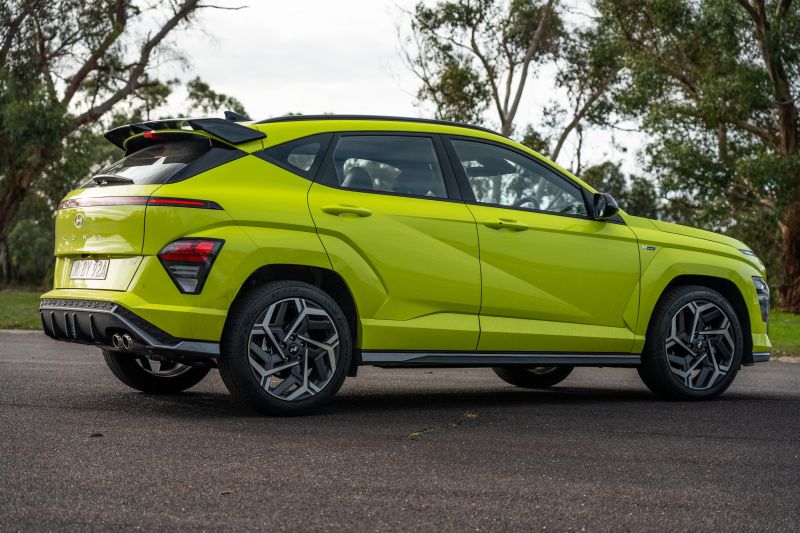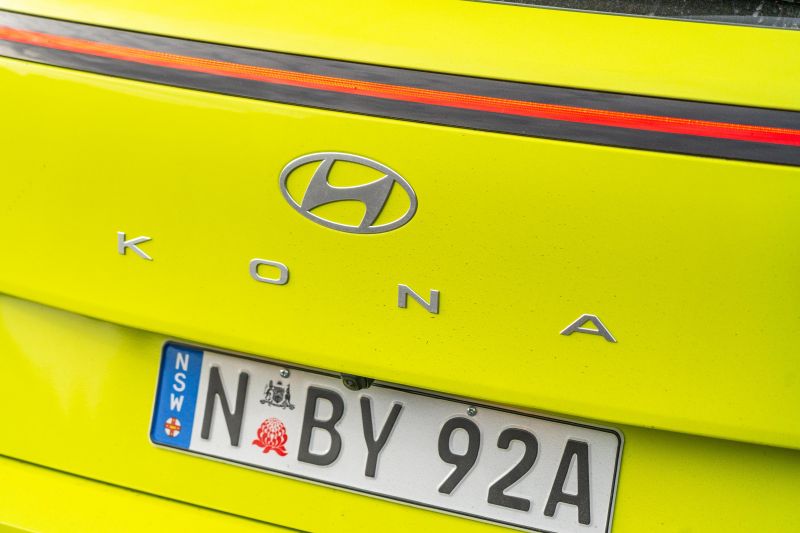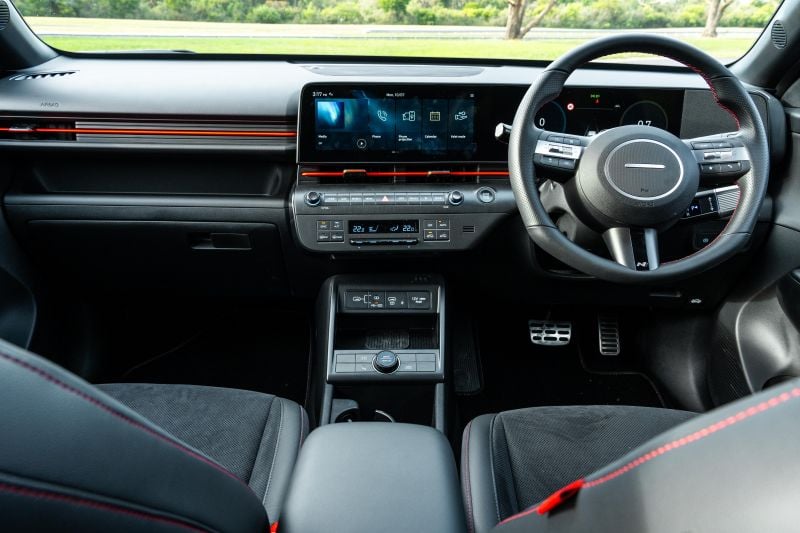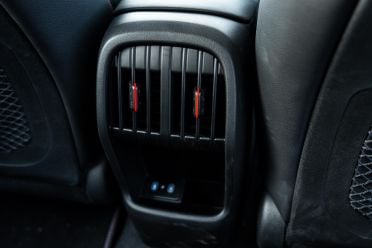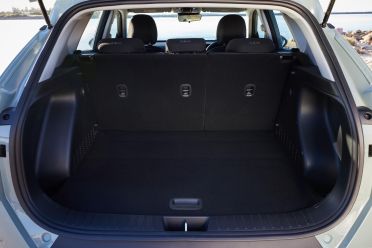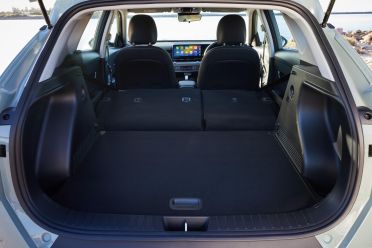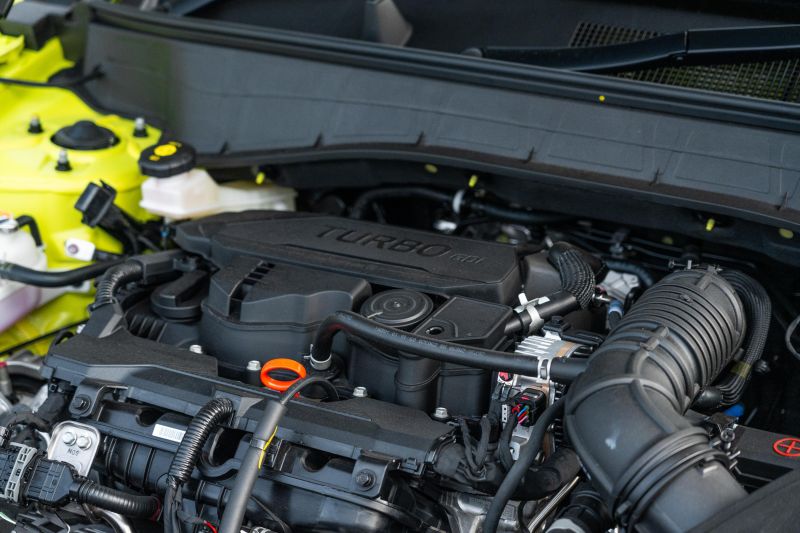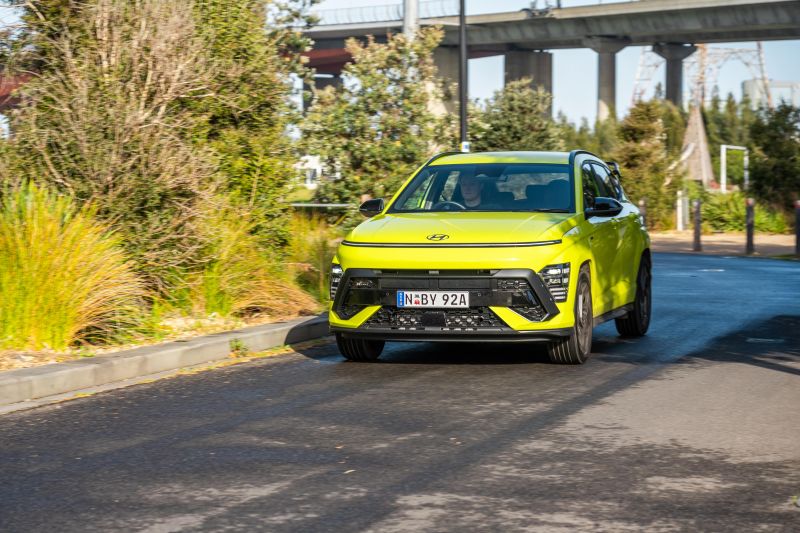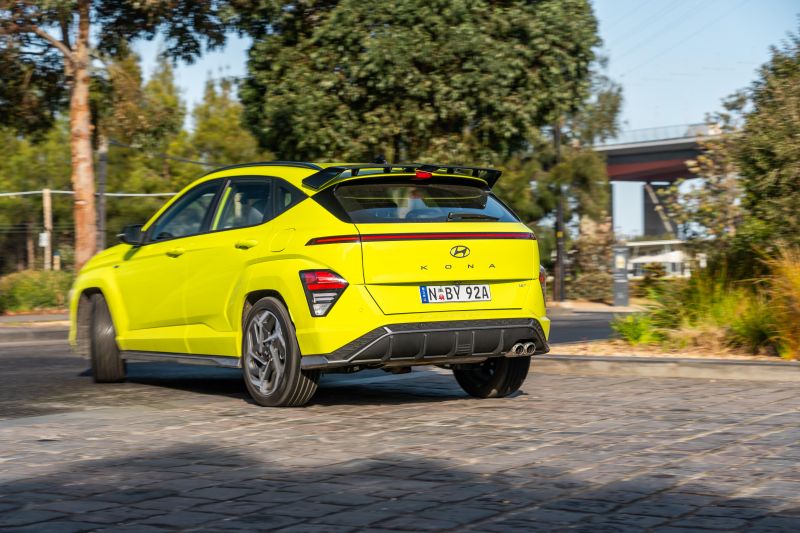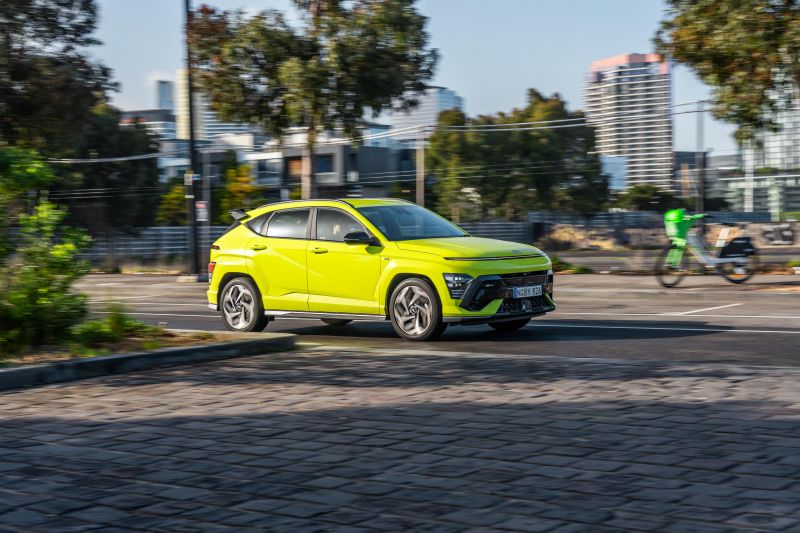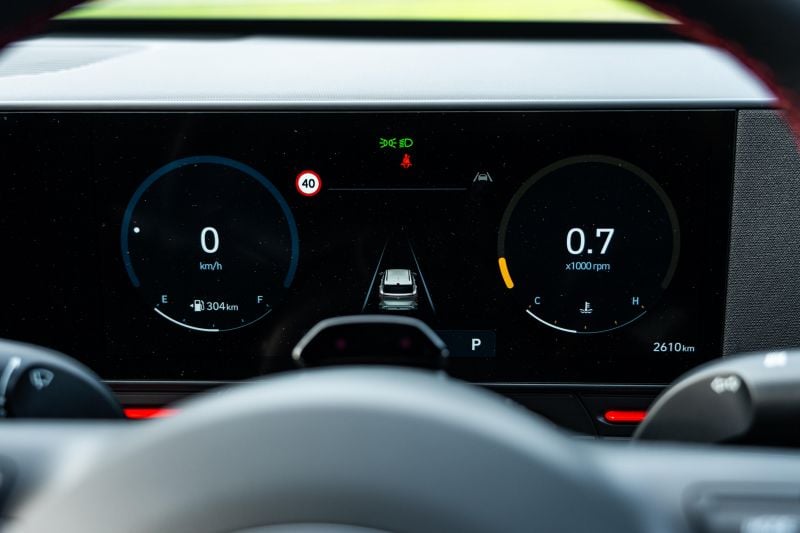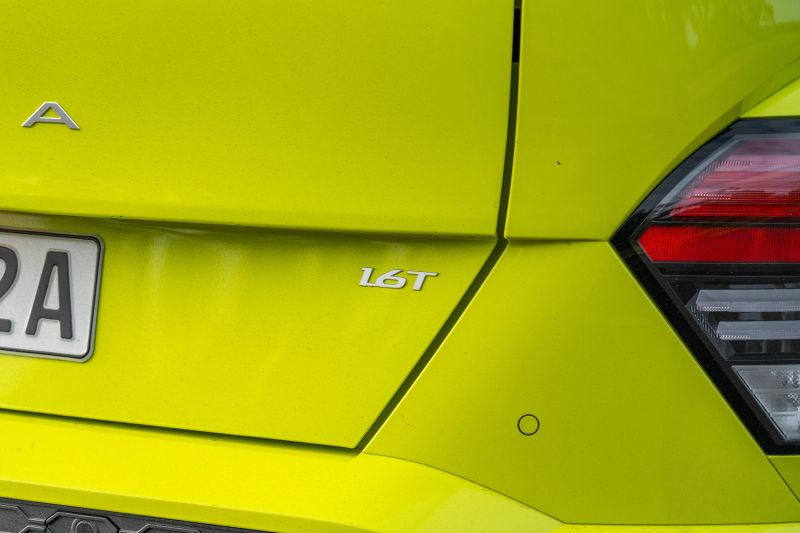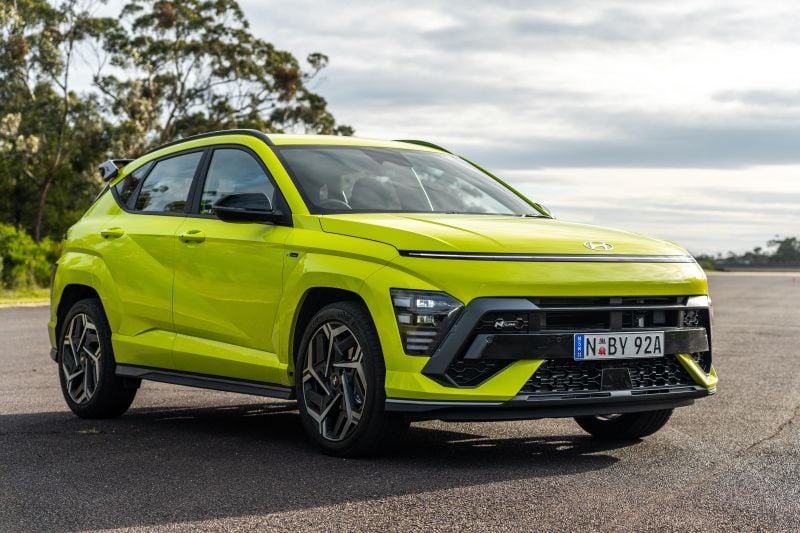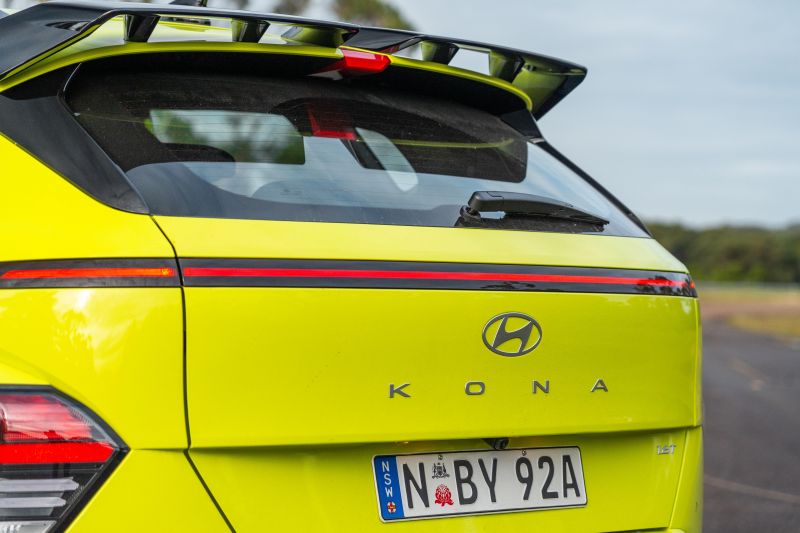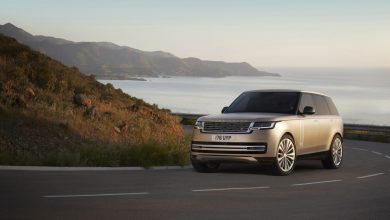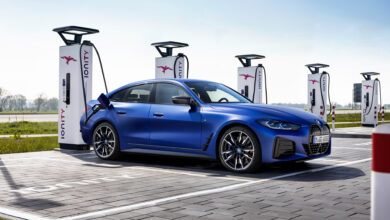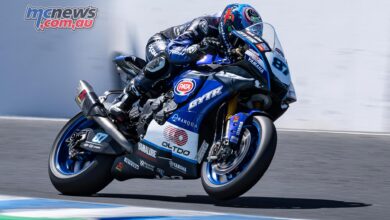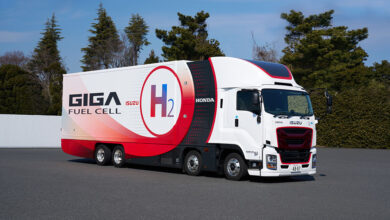2023 Hyundai Kona N Line 1.6T AWD review
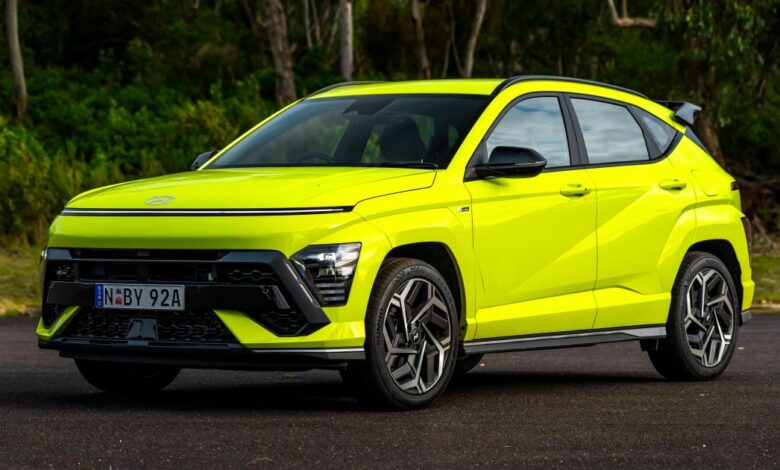
The original Hyundai Kona was a funky, angular little thing. Based loosely on the i30 Hatch’s platform and one of the earlier entrants into the properly compact SUV class, the first iteration was hugely successful for the Korean brand.
Now, there’s a new one. Based on the same platform as the Kia Niro as well as the i30 Sedan (Avante or Elantra in other markets), the new 2023 Hyundai Kona is bigger and better than ever.
It’s on a more advanced platform with updated engines and the latest in Hyundai’s infotainment technologies, and now has more space to better compete with the likes of the Kia Seltos and Nissan Qashqai.
The Kona also offers a litany of variants in a time where most rivals are simplifying their line-ups. By the end of the year there will be no fewer than four drivetrains available across four trim levels and two appearance packages.
The eye-searingly yellow example you see here is the 2023 Hyundai Kona N Line 1.6T AWD.
N Line versions of the new Kona are a little confusing. With the turbo petrol AWD drivetrain, there’s only N Line and Premium N Line versions available, where the standard Kona and Premium versions are available with 2.0 FWD petrol and 1.6 Hybrid (HEV) drivetrains, which can then be optioned with the N Line Package.
Perhaps more noteworthy is the fact the latest Kona 1.6T AWD picks up a new eight-speed automatic transmission, which should be a welcome improvement over the old seven-speed dual-clutch transmission (DCT). The N Line Package also brings a handsome set of extra features over the base Kona specification – is it the Goldilocks variant?
How much does the Hyundai Kona N Line 1.6T AWD cost?
The car you see here is priced from $40,000 before on-road costs.
It’s positioned about mid-way through the range, and is your most affordable ticket into the Kona with a turbocharged AWD drivetrain. For another $6500 you can have a decked-out Kona Premium N Line with the same engine.
Pricing for the Kona Electric hasn’t been revealed ahead of its release in the fourth quarter, but we’re expecting a line-up of variants including Kona and Premium trim levels with the N Line option package on both. Hyundai has also confirmed it will continue to offer two battery sizes with the new iteration.
There’s quite a lot of metal you can get for around $40,000 in the small SUV class, with sporty alternatives including the GWM Haval Jolion S ($35,990 D/A), Kia Seltos Sport+ 1.6T AWD ($39,300) Mazda CX-30 G25 Touring SP AWD ($42,510), Mitsubishi Eclipse Cross Exceed AWD ($42,990), Nissan Qashqai ST-L ($42,190), and the VW T-Roc R-Line ($47,090).
Other rivals for similar money include the Honda HR-V (from $36,700 D/A), Renault Arkana Intens ($41,000), Subaru Crosstrek AWD 2.0S ($41,490) and the Toyota Corolla Cross GXL AWD Hybrid ($43,230).
2023 Hyundai Kona pricing:
- Kona
- 2.0 FWD: $32,000
- 1.6 HEV FWD: $36,000
- Kona N Line
- 1.6 HEV FWD: $40,000
- 1.6T AWD: $40,000
- Kona Premium
- 2.0 FWD: $39,500
- 1.6 HEV FWD: $43,500
- Kona Premium N Line
- 1.6 HEV FWD: $46,500
- 1.6T AWD: $46,500
Prices exclude on-road costs
What is the Hyundai Kona N Line 1.6T AWD like on the inside?
The new Kona is a world away from its predecessor in the cabin, with a greater focus on upmarket design and technology, as well as more space.
All N Line versions feature dual 12.3-inch high-resolution displays for the driver’s instrument cluster and infotainment touchscreen, both running Hyundai’s latest software interface.
The digital instrument cluster is quite basic and limits configurability to different dial outlines and a few different menus between the dials, but the added screen size and minimalist design feel quite futuristic.
Animations are fluid and the refresh rates are good, which carries over to the central display. In this specification there’s no satellite navigation, but it does get wireless Apple CarPlay and Android Auto in addition to DAB radio as well as Hyundai’s Bluelink connected services.
The tiles on the main menu are reminiscent of Genesis’s take on the existing Hyundai/Kia software, and wireless smartphone mirroring is snappy and reliable. I did experience dropouts, but it was far more reliable than older Hyundai and Kia models with the feature. Plus, the 12.3-inch display’s resolution and response times feel nicely upmarket.
Comfort up front is pretty good, thanks in part to the airy and spacious feel of the new model as well as comfortable, shapely seats that in N Line-spec are trimmed in a combination of leather and Alcantara with bright red accents and top-stitching.
They’re manually adjustable, but there’s plenty of movement to find a good driving position, both in the seats and steering wheel. If you get one of the Premium models, you upgrade to 10-way power adjustment with memory and Zero Gravity function – which reclines the seats right back like a lounge. You also get eight-way power adjustment for the passenger with the same Zero Gravity feature in higher grades.
While the design and presentation is nice, with brushed metal-look bits and a pop from the red accents, the material quality is in need of improvement in the Kona. The surfaces lining the dashboard and doors are hard and scratchy, though high-contact points like front-centre armrest and door inserts are padded with a similar leather-suede combination as the seats.
Storage is good, though. The relocation of the gearshift to behind the steering wheel in all but the base petrol Kona mean the centre console is freed up with heaps of space for storage nooks and cubbies. There’s a spot for everything really.
There’s a modular cupholder area that can accommodate smaller cups, and there’s a shelf with a wireless phone charger under the centre stack that has a rubberised base to stop things from sliding around.
There are also a pair of USB-C ports and a 12V outlet under the centre stack, ahead of the Drive/Terrain mode selector and buttons for Auto Hold, parking camera and sensors.
Only the AWD version gets terrain settings due to the more capable underpinnings, though all versions of the Kona get several drive modes – Eco, Normal and Sport – which tailor the steering, throttle response and transmission accordingly.
I also appreciate the door bins that can accommodate larger bottles – this has been a grip of mine with Hyundai and Kia models of late.
Another key improvement with the new generation is the rear seat which, thanks to the longer body and wheelbase, has reasonable room for passengers larger than kids.
The body is 150mm longer (4355mm long) while the wheelbase as increased by 60mm to 2660mm. A 25mm increase in width rounds out the key dimensional changes.
All this means that an above-average adult like 6’1 me can sit behind my own driving position without pressing my knees up against the seat backs, and there’s better space for bulkier rear cargo like rear-facing child seats. Speaking of kids, there are ISOFIX anchors on the outboard positions and top-tethers behind all three.
There are also direction air vents behind the centre console and an extra set of two USB-C ports back there, as well as netted map pockets behind the front seats and a fold-down centre armrest with cupholders.
Like the second row of seating, the boot area has grown over the previous generation. There’s now 407 litres with all seats in play, up 33L on the old Kona.
Further, Hyundai quotes 1241 litres with the rear seats folded. That’s much more competitive with the likes of the Kia Seltos (433L-1428L) and Nissan Qashqai (429L-1524L). A space saver spare lives under the boot floor.
What’s under the bonnet?
In Australia, the Kona is available with no fewer than two petrol engines, a petrol-electric hybrid, and soon there will be a pair of pure-electric options too.
On test we have the updated 1.6 T-GDi AWD, which generates 146kW (6000rpm) and 265Nm (1600-4500rpm) from a four-cylinder turbocharged petrol engine. Drive is sent to an on-demand all-wheel drive system via a new eight-speed automatic transmission, which replaces the old seven-speed dry-clutch DCT.
The turbo is the thirstiest Kona drivetrain variant, with a combined fuel economy claim of 7.6 litres per 100 kilometres. Of note is the urban cycle figure of 10.0L/100km, while CO2 emissions are rated at 174g/km.
Hyundai still doesn’t fit stop-start technology to most of its local range, which no doubt would help to bring down urban fuel use in traffic. The Kona is still Euro 5-certified, though all versions with petrol tanks (including HEV) are compatible with cheaper 91 RON unleaded fuel.
All versions of the Hyundai Kona quote a maximum braked towing capacity of 1300kg, with a max tow ball download of 130kg.
How does the Hyundai Kona N Line 1.6T AWD drive?
The Kona has always been one of the sportier offerings in the segment. This new one, particularly in this specification, picks up where the old one left off.
Hyundai and Kia’s dry-clutch DCT never felt particularly sporty in everyday driving, rather feeling quite elastic and lethargic when getting off the line and when driving at low speeds around town.
The new eight-speed automatic, closely related to the unit used in the Tucson and Santa Fe, is much smoother and more responsive, and brings a welcome lift in overall refinement.
In normal driving the turbocharged torque down low gets you going in a effortless and relaxed manner, with the eight-speeder shifting quickly and intuitively balancing response with efficiency.
The turbocharged Kona has a buzzy, burbly exhaust note too, more on the outside than the inside, which is in keeping with the N Line’s sportier bent.
Despite wearing bigger 19-inch alloy wheels and low-profile 235/45 Kumho Ecsta performance tyres, the Kona N Line rides pretty well even over pimpled inner city tarmac.
There’s passive damping standard across the range, but AWD and HEV models also get a more sophisticated multilink rear suspension system over the standard 2.0 FWD’s torsion beam axle.
While in isolation you probably wouldn’t notice much of a difference, it helps make the car more settled over bumps and also keeps the rear more tied down in bends.
This doesn’t have enough grunt or soundtrack to feel like a proper sub-in for the Kona N, which thus far hasn’t been confirmed for a new generation as yet, but it certainly feels like one of the more dynamic small SUVs out there.
On the open road the added grunt of the turbocharged powertrain helps the Kona to feel more at home at triple figures, but there’s a bit of road noise to contend with which dulls refinement.
The smooth roads in South Korea clearly don’t warrant too much sound deadening, so that’s a knock in the Kona’s all-round armour.
Wind noise is fairly well suppressed, and the driver assistance systems are pretty handy too. Adaptive cruise control with stop/go functionality take the load off traffic jams on highways, while the Lane Following Assist function keeps you centred in your lane which can be helpful on longer journeys – though it could feel a little over-assisted for some
Standard blind-spot and rear cross-traffic assist further aid visibility when negotiating gaps or reversing out of tight spaces, the latter augmenting the reversing camera with dynamic guidelines as well as front and rear sensors.
What do you get?
Kona highlights:
- 18-inch alloy wheels with 215/55 tyres
- LED headlights, daytime running lights
- LED tail lights
- Heated, power-folding exterior mirrors
- Keyless entry and start
- Dual-zone climate control
- Rear air vents
- 4.2-inch digital instrument display
- 12.3-inch infotainment touchscreen
- Wireless Apple CarPlay, Android Auto
- Bluelink connected services
- DAB+ digital radio
Kona Premium adds:
- Blind Spot View Monitor
- AEB in reverse
- 3D surround-view camera
- Side parking sensors
- Acoustic front windscreen
- Rear privacy glass
- Dark grey cladding, silver skid plates
- LED dual-projector headlights
- LED front, rear indicators
- Power tailgate
- 12.3-inch digital instrument cluster
- Satellite navigation
- Bose 8-speaker premium sound
- Leather upholstery
- 10-way power driver’s seat
- 8-way power passenger seat
- Premium relaxation front seats
- Heated, ventilated front seats
- Heated steering wheel
- Heated rear seats
- Auto-dimming interior mirror
- Rain-sensing wipers
- Ambient lighting
N Line Package adds:
- Exterior
- N Line bumpers, skid plates, side skirts
- Gloss black rear spoiler
- N badging, wheel caps
- 19-inch wheels with 235/45 tyres (2.0 MPi)
- 18-inch alloy wheels (HEV)
- Chrome twin exhaust
- Black mirror caps, beltline
- Body coloured cladding
- Interior
- Leather/Alcantara trim
- N steering wheel
- Red air vents, seat highlights
- Dark metal trim highlights
- Black headlining
- Alloy pedals
- Sports scuff plates
- Extras over Kona (base):
- LED dual-projector headlights
- LED front, rear indicators
- Power tailgate
- 12.3-inch digital instrument cluster
- Auto-dimming interior mirrors
- Rain-sensing wipers
Is the Hyundai Kona N Line 1.6T AWD safe?
There is currently no ANCAP or Euro NCAP rating for the new Hyundai Kona.
Standard safety equipment includes:
- 7 airbags incl. front-centre airbag
- Adaptive cruise control with stop & go
- Autonomous Emergency Braking (AEB)
- Pedestrian, Cyclist detection
- Forward, Reverse
- Driver attention monitoring
- Blind-spot assist
- High-beam assist
- Lane Following Assist
- Lane keep assist
- Leading Vehicle Departure Alert
- Parking sensors front, rear
- Rear cross-traffic assist
- Rear occupant alert
- Reversing camera
- Safe exit warning
- Tyre pressure monitoring
How much does the Hyundai Kona N Line 1.6T AWD cost to run?
The Hyundai Kona is backed by a five-year, unlimited-kilometre warranty.
Maintenance will be required every 15,000 kilometres or 12 months in the 2.0-litre petrol and 1.6-litre hybrid, and every 10,000 kilometres or 12 months in the turbocharged petrol.
The first five services in both the 2.0 MPi and the 1.6 T-GDi will set you back $399 each – although that’s good for 75,000km in the 2.0 MPi, and 60,000km in the 1.6 T-GDi due to their different distance requirements.
I saw an indicated return of 8.5L per 100km over 485km of mixed conditions over a week of commuting, and a bit of freeway driving thrown in too. It’s up on the official combined claim, and on the higher side for the segment – one reason to go for the upcoming Kona Hybrid for the same money.
CarExpert’s Take on the Hyundai Kona N Line 1.6T AWD
Hyundai has made the Kona a whole lot more competitive in one of the most hotly-contended segments in market.
With its extra size, technology and drivetrain refinements, the new Kona is one of the top picks in class thanks to its wide choice of variants and breadth of capabilities.
Yes the looks are polarising, but that’s always been a Kona trait. Now, it’s no longer hampered by a tiny back seat and a lack of electrification options. There should be a Kona for just about everyone at this point, especially once the Hybrid and Electric arrive at the end of the year.
As for whether this is the specification to go for, I think the 1.6 T-GDi AWD is too expensive and thirsty to really make a lot of sense. You’re not going to be taking this off-road so the AWD only makes if you really want traction for adverse weather or the odd stint down a gravel trail.
For me, the Kona Hybrid shapes as the best option – even if you have to wait until the fourth quarter to get it – given it’s the same price as this turbo all-wheel drive option if you want the N Line bits. Otherwise you can save $4000 while cutting fuel use by almost 50 per cent based on official figures.
On a base Kona 2.0 FWD or Kona 1.6 HEV FWD, the N Line package brings desirable items such as projector LED headlights and a 12.3-inch digital instrument cluster, as well as a power tailgate and rain-sensing wipers. As a pseudo mid-range variant, it makes sense if you want those items without spending up on the Premium.
But there’s a few months wait before we can have a try of the electrified Kona variants. If the related Kia Niro is anything to go by, however, the Kona Hybrid and Kona Electric should shape as compelling options in a segment still limited in terms of electrified alternatives – stay tuned.
Click the images for the full gallery
MORE: Everything Hyundai Kona
